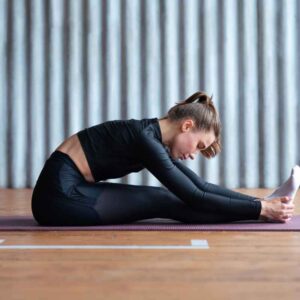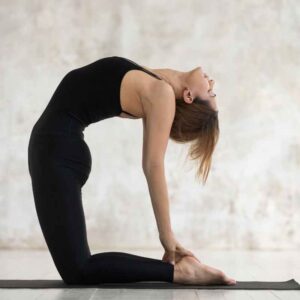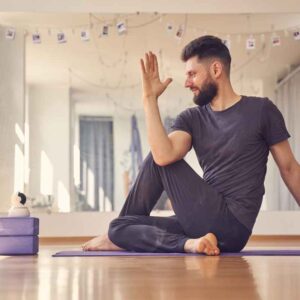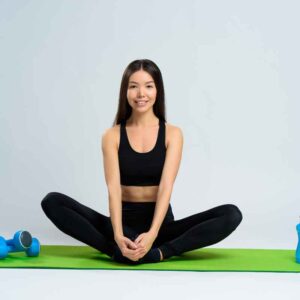Yoga For Flexibility: Tips And Best Poses

Yoga has many benefits and one of the essential benefits is flexibility. Learning yoga for flexibility is a great journey. This blog will guide you and help you to practice best yoga poses that helps to increase flexibility. Beginners can also join a yoga teacher training program for learning basics to advance level of yoga.
Understanding Yoga For Flexibility
Flexibility is nothing but just your body’s range of motion of your joints and muscles. Having good flexibility in the body reduces the risk of injury. A flexible body allows for a broader range of motion, making daily activities more comfortable.
Benefits Of Flexibility
Improved Posture
Maintaining a good posture is really important. Bad posture can provide you discomfort and can have health issues in the long term. By enhancing flexibility through yoga you can encourage the body to find its natural and upright position.
Stress Reduction
Flexibility is not only for the body’s upright position it is also extended to mental and emotional flexibility as well. Yoga activity promotes mental resilience, helping individuals adapt to life’s challenges with greater ease.
Joint Health
Flexibility improves your joints health. Stretching through yoga helps in reducing stiffness and promotes good health of joints.
Aging
Flexibility is often associated with aging gracefully. As we grow older, maintaining flexibility becomes crucial for preserving mobility, independence, and a high quality of life.
Flexibility Tips
Be Consistent
Making your body flexible is not a job of 1 week, it requires consistency by practicing yoga. One can not say how much time it will take to be flexible as it depends on one’s body and its daily practice.
Regular Warm-up
Before starting practicing yoga for flexibility one should warm up. Stretching or jumping jack or other warm up exercises are better to prepare your body for the flexibility-enhancing poses.
Understand Your Body
It is very important to know how much effort and practice your body needs for practicing yoga for flexibility. Overdoing anything is not good as it can take you to injury. Also there are some yoga poses which are difficult to perform but some try them without any help and get injured especially if you are new to yoga you should ask help from someone or should join 100 Hour Yoga Teacher Training for learning basics of yoga where you will also get certification of yoga.
Best Yoga Poses For Flexibility
Let us see which yoga poses are best for enhancing flexibility:-
Forward Folds
Uttanasana (Standing Forward Bend) – Steps to do Uttanasana

- Begin by standing in Tadasana (Mountain Pose) with your feet hip-width apart. Ensure that your weight is evenly distributed on both feet.
- Gently lower the torso towards the floor and try to reach the floor.
- The knees must stay straight without any bent.
- Now breath deeply and grab hold of your ankles and stay for about a minute and let your head and shoulders loose.
- Now slowly roll back to the standing posture.
Paschimottanasana (Seated Forward Bend) – Steps to do Paschimottanasana

- Sit erect on the ground and stretch your legs in front.
- Bring your feet together
- Inhale and stretch your hands up towards the sky.
- Pick your spine up and exhale as you bring your upper body down pivoting at the hip joint.
- Grab your big toes with the first two fingers and thumbs of your hands.
- Try to stretch further (if you can) and try to lower your elbows on the ground beside your knees and rest your chin on top of your knees.
- Breath naturally and be in the same position for about 30 seconds.
- Slowly release your feet and inhale as you raise your upper body and stretch your arms skyward stretching your spine.
Backbends
Bhujangasana (Cobra Pose) – Steps to do Bhujangasana

- Lie on your stomach and bring your chin to the mat
- Place your palms under your shoulders.
- Inhale and lift your chest, hips remain on the floor
- Breath and relax your shoulders down and press your chest forward
- Exhale and gently lower your chest and bring your chin slowly to the mat.
- Rest your arms down by the sides.
Ustrasana (Camel Pose) – Steps to do Ustrasana

- Sit and slowly stand on your knees.
- Keep knees and hip width apart
- Raise your right hand up
- Exhale and place your right palm on your right heel and left palm on the left heel.
- Now inhale and push your hips forward.
- Relax your head and open your chest.
- Remain in the camel pose for 20-30 sec
- Now exit the pose in the same way as it was done.
Twists
Ardha Matsyendrasana (Half Fish Pose) – Steps to do Ardha Matsyendrasana

- Begin by sitting on the floor with your legs extended straight in front of you
- Bend your right knee and bring your right foot to the outside of your left hip. Your right knee should be pointing straight up.
- Cross your left foot over the right knee, placing it on the floor outside your right thigh. The sole of your left foot should be flat on the floor.
- Inhale and lengthen your spine, sitting up tall.
- As you exhale, hug your right knee with your left arm and place your right hand on the floor behind you. Use your right hand as a support to keep your spine long.
- Hold the pose for about 20-30 seconds, gradually increasing the duration as you become more comfortable.
- To release the pose, gently unwind and return to the starting position. Extend both legs in front of you.
Hip Openers
Pigeon Pose (Eka Pada Rajakapotasana) – Steps to do Pigeon Pose

- Begin in a tabletop position on your hands and knees. Ensure your wrists are under your shoulders, and your knees are under your hips.
- Slide your right knee forward towards your right hand. Place your right foot towards the left edge of your mat, creating a 45-degree angle with your thigh.
- Slide your left leg straight back, pointing your toes. Ensure your hips are square to the front of your mat.
- Check that your right hip is externally rotated, and your left hip is pointing down towards the mat.
- Square your hips as much as possible to the front of the mat. Your pelvis should be level.
- Inhale and lengthen your spine. Lift your chest and look forward.
- As you exhale, slowly walk your hands forward, lowering your chest towards the mat. Keep your arms active and engage your core.
- Hold Pigeon Pose for about 30 seconds to 2 minutes, depending on your comfort level. Breathe deeply and relax into the stretch.
Butterfly Pose (Baddha Konasana) – Steps to do Butterfly Pose

- Begin by sitting on the floor with your legs extended straight in front of you
- Bend your knees and bring the soles of your feet together, allowing your knees to fall open to the sides.
- Bring your heels as close to your pelvis as comfortable. Your feet should touch each other, and your knees should be pointing out to the sides.
- Hold onto your feet with your hands.
- Sit up tall, lengthening your spine. Avoid rounding your back. Engage your core muscles to support a straight and upright posture.
- Use your hands to gently press down on your thighs, encouraging them towards the floor. This action helps open up the hips.
- Breathe deeply and steadily. Inhale as you lengthen your spine, and exhale as you fold forward slightly, maintaining the engagement in your core.
- Hold the Butterfly Pose for 30 seconds to 1 minute, breathing steadily and maintaining a sense of relaxation.
- To release the pose, sit back up, extend your legs, and shake out your legs to release any tension.
Conclusion
Practicing yoga daily will help you to increase your flexibility. There are tips and poses for enhancing flexibility in your body. Joining Yoga teacher training may help you a lot if you are a beginner and want to learn basics. Yoga poses like Uttanasana, Paschimottanasana, Bhujangasana and other poses will definitely help you to be more flexible than before.



